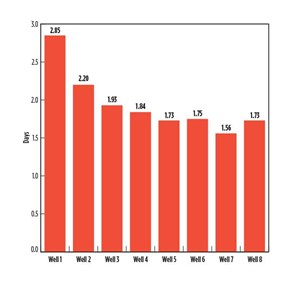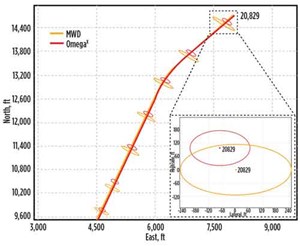Gyro technology improves wellbore accuracy, reduces survey times in offshore operations
The need to drill wells more efficiently, with less nonproductive time, led to a wave of new technology releases, designed to significantly reduce the days-versus-depth curve, over the past decade. The average time to drill a well fell dramatically after iterative cycles of innovation, yielding greater technology implementation.
The direct link between high-accuracy wellbore surveying and better wellbore placement is clear. Gyroscopic survey technology is acknowledged as a superior option versus magnetic MWD tools, due to its ability to provide more accurate, more precise data without fear of magnetic interference. As the complexity of well design evolved, gyro-while-drilling (GWD) systems further expanded the operating envelope using the technology, allowing surveys to be collected in real time while drilling. Additionally, the pioneering of solid-state gyro technology led to the introduction of new systems that were more rugged and accurate than earlier offerings. Offshore conditions, where wellbore collision could result in a catastrophic HSE event, demand this type of continuous innovation.
TECHNOLOGY
GWD technology collects real-time survey data to allow more accurate wellbore placement and improved operational safety. Historically, GWD survey tools were limited by the angle of inclination. However, the evolution in Gyrodata’s GWD systems enabled the collection of real-time data at all inclinations and in any direction.
In a conventional gyro system, the modular gyro tool is combined with a host MWD and telemetry system, with the GWD system providing continuous inclination and toolface from vertical while sliding, and directional surveys on demand. The use of MWD tools is severely limited in areas where magnetic interference is present, but by its measurement principle, a gyro is not affected by the same problem. This not only means improved survey accuracy but that the sensors can be run closer to the bit in the BHA, eliminating the need for nonmagnetic spacing collars.
GWD70, as referenced below, is the notation for Gyrodata’s GWD system and its maximum inclination angle, in this case, 70°. The GWD system is chosen, based on the operator’s highest planned survey inclination, complete drilling plan, well type, and compatibility with other technologies that will be incorporated into the BHA. GWD systems can be run with most commonly available MWD tools and eliminate the need to use wireline gyros to orient or steer the drilling assemblies. When precise wellbore guidance for collision avoidance and trajectory placement are critical, running a GWD system to obtain real-time knowledge of wellbore position to enhance performance and safety can be a major differentiator.
Gyrodata introduced solid-state gyro technology to overcome the challenges associated with harsher downhole conditions. One system, OmegaX, is an all-attitude, solid-state drop gyro that is powered by a new sensor package with two independent, three-axis sensor probes. These solid-state sensor probes measure the earth’s rotational rate precisely and accurately, and are more rugged than conventional designs. The system is not affected by mass unbalance errors, which eliminates post-run calibrations, and it enables surveys to be collected during pipe connections, reducing necessary rig time. At only 19 in. long, including memory and data processing, the system’s sensor package and electronics are significantly smaller than previous offerings, enabling greater flexibility related to landing in different BHA designs and configurations.
Tophole riser-less drilling operations with significant risk of wellbore collision. Another major operator was preparing for an upcoming five-well batch project on the Norwegian Continental Shelf. The project involved drilling the tophole section with challenging riser-less operations from a platform. The project required strict adherence to the planned well trajectory, making wellbore accuracy and risk mitigation key objectives. When drilling near other wells, the operator’s internal regulations stated that MWD surveys could not be used unless there was a minimum clearance of 20 m between offset wells. Magnetic interference was a concern, making high-accuracy gyro surveys a necessity. The operator also hoped to reduce costs by implementing a new technology solution.
Gyrodata recommended using the GWD70 system to provide real-time azimuth, inclination, and toolface measurements for wellbore placement. The system featured an intelligent mode option that allowed increased sampling time and improved data quality when subjected to significant BHA movements, which were typical on floating structures and during riser-less operations. Gyro surveys were taken when drilling the surface holes on each of the five wells to approximately 1,640-ft MD, at which point the MWD surveys had cleared from magnetic interference. The GWD70 system integrated seamlessly with the 9½-in. modular collar, making it possible to switch to conventional magnetic surveys, once free from interference without compromising sensor-to-bit distance.
All five wells were placed successfully, according to the operator’s plan, and with reduced risk of wellbore collision. The GWD system’s intelligent mode, combined with Gyrodata survey procedures tailored to this type of operation, ensured the avoidance of resurveying that would normally cause washout, loss of build, and additional operation time. With magnetic interference present, the operator had previously expected to conduct approximately six wireline runs for a total survey time of approximately 11 hr. As the GWD70 system took surveys at an average time of 23 min. per well and eliminated the need for the wireline tools, the operator saved approximately 1 hr and 22 min. per survey, equating to more than 56 hr for the 41 surveys. This resulted in an estimated cost-savings of $700,000 and improvements to safety on the rig.
An operator in the North Sea needed to drill and set eight conductors on a 36-slot platform ahead of their planned timeline. The field was populated heavily with a complex web of existing wells, increasing the probability of collision. The operator needed to take extremely accurate surveys to maintain high-enough separation factors between wells in the crowded field, to meet strict operational and HSE regulations. Each well needed to be drilled from spud at 520 ft to TD at approximately 1,600 ft. Previous runs on the field had taken the operator an average of 2.5 days per conductor.
Gyrodata recommended running a GWD70 system to meet the dual objectives of wellbore placement accuracy and survey efficiency. Running the GWD system enabled increased survey accuracy over conventional MWD tools, which improved well separation factors. In addition, Gyrodata provided the operator with engineers to support BHA handling during tool changeovers, ensuring the efficiency of the batch-set operation.

The GWD70 system with intelligent mode allowed surveys to be collected in the riser-less conditions with minimal surveying time, providing accurate directional surveys and steering information to drill to casing point. A total of eight wells at 1,092 ft, each, was completed, bringing the total amount of drilled depth to 8,376 ft. Gyrodata helped the operator to complete the batch of wells ahead of their planned time, taking an average of two days per conductor versus the 2.5 days per conductor during the previous batch drilling campaign, Fig. 1. The operator had planned on 20 days for the operation, but Gyrodata’s assistance allowed them to complete the batch in just 15.6 days and with greater accuracy than before. Additionally, the risk of wellbore collision in the crowded field was reduced significantly via the increased precision and accuracy made possible by the GWD70 technology.
Extended-reach applications demanding extremely accurate wellbore placement. An operator in the North Sea was drilling an extended-reach lateral from a platform. After drilling the wellbore to TD at 20,829 ft, the operator decided to run a gyro survey to verify the accuracy of the data from the MWD survey, which had been corrected with in-field referencing, multi-station analysis, and BHA sag. The operator’s end goal was to reduce the ellipse of uncertainty and improve the wellbore’s final placement. The operator originally proposed a continuous wireline gyro survey to accomplish these goals but chose to run a solid-state drop gyro survey instead, based on Gyrodata’s recommendations for the project.

The OmegaX solid-state drop gyro survey had several advantages over the more traditional continuous wireline gyro survey. Due to improvements to solid-state sensors over those used in spinning-mass gyros, the OmegaX system was able to provide more accurate surveys than those of previous technologies. While traditional gyros had to be placed in a thermal flask to operate at temperatures up to 302° F (150° C) for extended time periods, the new system could do so without the extra equipment or time limitation. These improvements made the system far more durable and reliable in harsher downhole environments.
The solid-state drop gyro system also eliminated a significant amount of survey time versus an equivalent wireline run, which would have taken approximately 12 hr, including rig-up and rig-down, on this project. In addition, using the system reduced the ellipse of uncertainty by 56% and lateral uncertainty by 46%, Fig. 2. This led to the final wellbore position being moved 63 ft laterally and 121 ft high-side. The system’s two independent sensors also provided gross error check capability, which provided additional confidence in the sensors’ final survey results and improved survey accuracy.
CONCLUSION
Wellbore placement accuracy will remain critical to the success of offshore operations, particularly those where there is a high risk of wellbore collision. Companies that implement gyro technology will be able to mitigate such risks and improve the separation factor between their wells, reducing positional uncertainty and increasing safety. Solid-state gyro technology represents an additional step forward in the journey to consistently better surveying and well placement, with the latest releases in both solid-state drop gyros (as discussed above) and solid-state GWD systems providing even greater accuracy in a more durable package meant to survive for longer in harsh downhole conditions.
- Advancing offshore decarbonization through electrification of FPSOs (March 2024)
- Subsea technology- Corrosion monitoring: From failure to success (February 2024)
- Driving MPD adoption with performance-enhancing technologies (January 2024)
- Digital transformation: A breakthrough year for digitalization in the offshore sector (January 2024)
- Offshore technology: Platform design: Is the next generation of offshore platforms changing offshore energy? (December 2023)
- 2024: A policy crossroads for American offshore energy (December 2023)
- Applying ultra-deep LWD resistivity technology successfully in a SAGD operation (May 2019)
- Adoption of wireless intelligent completions advances (May 2019)
- Majors double down as takeaway crunch eases (April 2019)
- What’s new in well logging and formation evaluation (April 2019)
- Qualification of a 20,000-psi subsea BOP: A collaborative approach (February 2019)
- ConocoPhillips’ Greg Leveille sees rapid trajectory of technical advancement continuing (February 2019)


